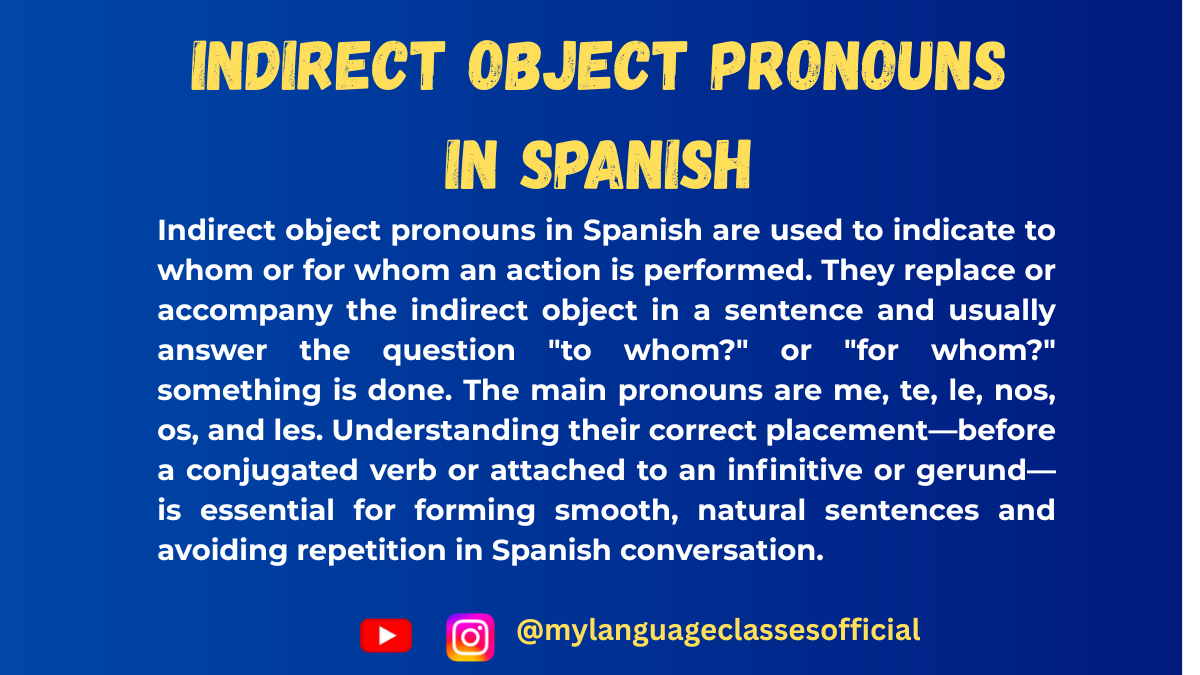Your cart is currently empty!
Tag: indirect object pronouns in Spanish for learners
-

Indirect Object Pronouns in Spanish
Mastering Indirect Object Pronouns in Spanish
When learning Spanish, understanding indirect object pronouns (pronombres de objeto indirecto) is essential to achieving fluency. These little words pack a big punch, streamlining sentences and helping you sound more natural. In this blog post, we’ll dive into their forms, usage, and provide plenty of examples to solidify your understanding.
What Are Indirect Object Pronouns?
Indirect object pronouns answer the question “To whom?” or “For whom?” an action is performed. They replace the indirect object in a sentence, often saving time and avoiding repetition.
In English:
- He gave her the book.
The pronoun “her” replaces the indirect object (to whom the book was given).
In Spanish:
- Él le dio el libro.
The Indirect Object Pronouns in Spanish
Here are the indirect object pronouns in Spanish:
Pronoun English Equivalent me to/for me te to/for you (informal) le to/for him, her, you (formal) nos to/for us os to/for you (informal plural, used in Spain) les to/for them, you all
Placement of Indirect Object Pronouns
The placement of indirect object pronouns depends on the verb tense and type of verb construction.
1. Before a Conjugated Verb
The indirect object pronoun comes before a conjugated verb.
- María me dio un regalo.
(María gave me a gift.) - ¿Te mandaron la invitación?
(Did they send you the invitation?)
2. Attached to an Infinitive or Gerund
When there’s an infinitive (-ar, -er, -ir) or a gerund (-ando, -iendo), the pronoun can be attached to the verb or placed before the conjugated verb.
- Voy a contarte una historia.
(I’m going to tell you a story.) - Te voy a contar una historia.
(I’m going to tell you a story.) - Estamos escribiéndoles una carta.
(We’re writing them a letter.) - Les estamos escribiendo una carta.
(We’re writing them a letter.)
3. With Commands
- Affirmative commands: Attach the pronoun to the verb.
Dale el libro. (Give him the book.) - Negative commands: Place the pronoun before the verb.
No le des el libro. (Don’t give him the book.)
Indirect Object Pronouns with Clarification
Sometimes, indirect object pronouns like le and les can be ambiguous (they could refer to him, her, it, or them). To clarify, Spanish uses the preposition “a” followed by the indirect object.
- Él le dio un regalo a María.
(He gave a gift to María.)
Even when it’s clear, native speakers often include this redundancy for emphasis:
- A mí me encanta el chocolate.
(I love chocolate.)
The Double Object Pronoun Rule
In Spanish, you can use both a direct object pronoun and an indirect object pronoun in the same sentence. However, when both pronouns begin with “l” (le or les), the indirect object pronoun changes to se.
- Él le dio el libro a María. → Él se lo dio.
(He gave it to her.)
This rule avoids awkward repetition of sounds like “le lo”.
- ¿Les diste la carta? → ¿Se la diste?
(Did you give it to them?)
Practical Tips for Mastery
- Practice Common Verbs: Some verbs are frequently used with indirect object pronouns, such as dar (to give), decir (to say), preguntar (to ask), and gustar (to like).
Example:- ¿Me das tu número de teléfono? (Can you give me your phone number?)
- A ellos les gusta bailar. (They like dancing.)
- Immerse Yourself: Watch movies or read books in Spanish, paying attention to how these pronouns are used.
- Drill Sentence Structures: Write or say sentences with and without the pronouns to see the difference.
Exercises for Practice
- Rewrite the sentences using indirect object pronouns:
a) Yo di flores a mi mamá.
b) Estamos escribiendo una carta a nuestros amigos.
c) Juan va a dar el regalo a ti. - Translate into Spanish:
a) She told him the truth.
b) They bought us a souvenir.
c) I am going to explain the problem to you.
Final Thoughts
Mastering indirect object pronouns is a stepping stone toward fluency in Spanish. With practice and immersion, they’ll soon feel like second nature. Remember to focus on placement, usage rules, and practice as much as possible in real-life scenarios. ¡Buena suerte!
Have questions or want more practice? Drop them in the comments below!
If you found this guide helpful, I’d love to hear from you! Share your thoughts in the comments below or connect with me on social media. For more tips, resources, and inspiration, visit my blog at mylanguageclasses.in. Follow on Instagram and subscribe on YouTube
Master Spanish indirect object pronouns with rules, examples, and tips to speak more fluently and naturally. Simple guide for all learners.
- He gave her the book.
